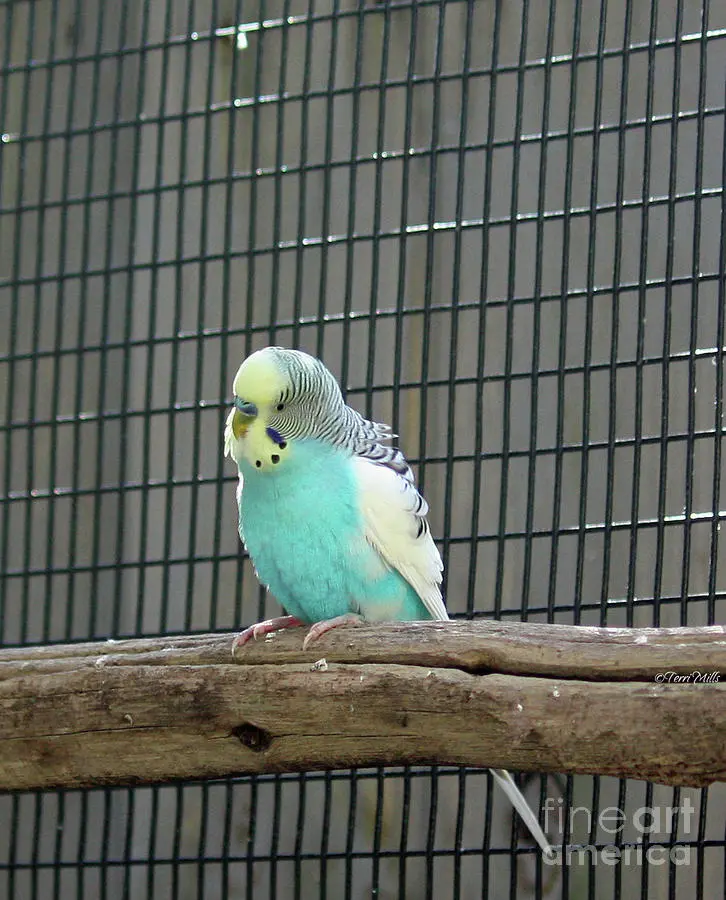Budgie Bird: Types, Characteristics, Behavior, and Care Guide
Welcome to the enchanting world of budgie birds! These small, vibrant, and immensely social creatures, also known as budgerigars or parakeets, offer endless joy and companionship to avian enthusiasts around the world. Originating from the arid plains of Australia, budgies have captured the hearts of pet owners due to their curious nature, charming vocalizations, and stunning array of colors. Whether you’re a seasoned bird owner or considering your first feathered friend, this comprehensive guide delves deep into all aspects of budgie care, behavior, diet, and more. Get ready to explore everything from their types and physical characteristics to health care tips and intriguing fun facts.
Types of Budgie Birds
Budgies are incredibly diverse, spanning several types that each bring their unique flair to the avian world. The primary distinction is between English Budgies and Australian Budgies. English Budgies, sometimes called Show Budgies, are notably larger and more robust, akin to well-fed aristocrats at a grand ball, flaunting their grandiose appearance with every flutter. On the other hand, Australian or Wild Budgies are smaller and more streamlined, like nimble athletes expertly dodging through the dense foliage of the Outback.
The essence of their difference lies in size, build, and personality. English Budgies are often bred for their temperamental traits and aesthetics, whereas the Australian Budgies hold onto their natural vigor and inquisitiveness. This comparative vastness brings an element of choice, allowing potential owners to decide based on their lifestyle and what they seek in their avian companion.
English Budgie vs. Australian Budgie
When examining the specific traits of English Budgies versus Australian Budgies, several notable distinctions come to light, creating a fascinating spectrum of choices for potential budgie owners. Let’s break this down comprehensively:
Physical Characteristics
Size and Build:
- English Budgies: Larger in stature, typically measuring around 25 to 30 cm (10 to 12 inches) in length and weighing between 45 to 65 grams. Their bodies are robust with fuller feathers, rounder heads, and larger eyes, making them look quite plush.
- Australian Budgies: Smaller and sleeker, averaging 15 to 18 cm (6 to 7 inches) in length and weighing approximately 25 to 35 grams. Their streamlined bodies give them a more agile and lithe appearance.
Color Variations:
- English Budgies: These budgies boast a more extensive array of color mutations, including violet, mauve, and cinnamon, due to selective breeding. They present a vivid and diverse palette compared to their Australian counterparts.
- Australian Budgies: Their color is more natural, usually featuring shades of green, blue, and yellow, mirroring the wild budgies’ aesthetics. This simplicity remains a testament to their roots.
Behavior and Personality
Temperament:
- English Budgies: Tend to be calmer and more docile. They are often bred for their gentle demeanor, making them perfect for owners who seek a relaxed avian companion. Their laid-back nature can be likened to a serene, meditative garden.
- Australian Budgies: Adorn themselves with energy and playfulness. They are more animated and energetic, resembling a bustling playground full of vibrant activity. This makes them ideal for families with children.
Lifespan:
- English and Australian Budgies both generally enjoy similar lifespans, typically living between 5 to 10 years. However, Australian Budgies might possess a slight edge in longevity due to their resilient genetic makeup, potentially living a bit longer.
Breeding and Availability
Breeding Focus:
- English Budgies: Frequently bred for show purposes, highlighting their unique appearance and temperament. They are often more expensive and typically sourced through specialized breeders.
- Australian Budgies: More accessible and commonly available at pet shops, rescues, and casual breeders. They are generally more affordable, echoing their natural beauty and resilience.
Care Considerations Both types demand similar care regarding diet, housing, and social interaction. However, English Budgies, given their larger size, may require a slightly more spacious cage and could benefit from more frequent grooming.
As choosing between English and Australian Budgies involves contemplating their distinct characteristics, it’s crucial to reflect on your preferences regarding activity level, temperament, and aesthetic appeal. Each type offers unique attributes that cater to diverse lifestyles, making them delightful companions in their right.
Standard Budgie Varieties
Budgies come in a plethora of varieties, each with unique physical traits and personality nuances. Among the most recognized are the English Budgies and American Budgies, both selectively bred to highlight different features.
English Budgies:
- Size and Build: These budgies are grander, typically measuring 23 to 25 cm (9 to 10 inches) from beak to tail. They have a stocky body, rounder head, and shorter tail feathers, granting them a fuller look.
- Head and Beak: A broad, rounded head with a prominent forehead characterizes English Budgies. Their beaks are visibly larger and more robust compared to their American counterparts.
- Feathering: With luxurious and dense feathering, English Budgies appear fluffier and possess more complex patterns of vibrant colors.
- Temperament: English Budgies tend to be quieter and less vocal, suitable for owners who prefer a gentler companion.
American Budgies:
- Size and Build: Smaller and sleeker, they measure approximately 15 to 20 cm (6 to 8 inches) in length. They maintain a more streamlined appearance with noticeable agility.
- Head and Beak: Their heads are proportionately smaller, with a more slender look and a smaller beak.
- Feathering: Sporting shorter and less dense feathers, American Budgies present a less fluffed look but still showcases various colors, albeit with less intensity.
- Temperament: More active and vocal, American Budgies infuse a lively dynamic into their households.
Additional Variants:
- Cinnamon Budgies: Feature a captivating brown hue with darker markings.
- Dark-eyed Clear Budgies: Boast turquoise plumage with clear wings for a stunning contrast.
- Opaline Budgies: Exhibit a blend of blue and other hues, resulting in unique feather patterns.
Choosing between these varieties often depends on personal preferences, whether it’s the robust, calm demeanor of an English Budgie or the lively, vocal behavior of an American Budgie. Both stand to offer unparalleled joy and companionship with their distinct characteristics and charm.
Physical Characteristics
Budgies are celebrated for their vibrant plumage and delicate structure, making them a visual feast for bird enthusiasts. Their size, color variations, beak, and head structure all contribute to their unique appearance in the avian world. Imagine a nimble gymnast for American Budgies, contrasted with the stately presence of English Budgies each holds a unique charm.
Size and Dimensions of Budgies
Understanding the size and dimensions of budgies helps prospective owners make informed decisions about their needs and housing requirements.
| Feature | English Budgie | Australian Budgie |
|---|---|---|
| Length | 25 to 30 cm (10 to 12 inches) | 15 to 18 cm (6 to 7 inches) |
| Weight | 45 to 65 grams | 25 to 35 grams |
| Body Shape | Stocky and robust build, rounder head | Slimmer, more streamlined appearance |
Analysis:
- English Budgies, with their larger size and stately build, demand slightly more space and care, emphasizing their grand presence.
- Australian Budgies, mimicking their wild counterparts, offer agility and require less space, making them suitable for smaller living environments.
These physical divergences highlight the importance of tailoring their care and housing to fit their specific needs, ensuring a comfortable and enriching environment.
Plumage and Color Variations
Budgies are nothing short of a kaleidoscope, with their feathers offering an impressive variety of hues and patterns:
English Budgies:
- Luxurious feathers, often longer and denser
- Colors include vibrant greens, bright yellows, deep blues, and striking grays
- Display defined color markings, exhibiting richer shades and intricate patterns
Australian Budgies:
- Shorter, more streamlined feathers
- Colors feature natural greens, blues, and yellows
- Reflect more subdued, yet equally beautiful, natural hues
These plumage qualities, often a result of selective breeding, make English Budgies akin to an opulent tapestry, while Australian Budgies retain their pristine, natural charm, embellishing their environment with vivid beauty.
Beak and Head Structure
The beak and head structure significantly influence the functionality and aesthetic appeal of budgies.
English Budgies:
- Larger and more robust beak, typically in light shades like pale yellow or pink
- Prominent, round head with a broader face and a significant forehead
- Enhanced head structure facilitates better feeding mechanics, allowing efficient seed cracking and environmental manipulation
Australian Budgies:
- Smaller, sturdier beak suited for agile feeding
- Proportionate, streamlined head contributing to their sleek appearance
These structural distinctions underscore the English Budgie’s capacity for a regal presence and the Australian Budgie’s agile, athletic demeanor.
Behavior and Temperament
Budgies, celebrated for their engaging behavior and temperament, exhibit various social interaction preferences, training capacities, and common behavioral traits that make them fascinating companions.
Social Interaction Preferences
Budgies thrive in social settings and display endearing interaction preferences:
Social Nature:
- Budgies require companionship and enjoy interaction with both humans and other birds. A solitary budgie can experience loneliness, potentially leading to behavioral issues such as feather plucking.
- Frequent human interaction or keeping them in pairs ensures their emotional well-being.
Behavioral Traits:
- Known for their curiosity and playfulness, budgies indulge in activities like swinging, climbing, and exploring.
- Their affectionate demeanor includes nibbling and staying close to their companions, displaying their social bond.
Temperament:
- Generally gentle and friendly, budgies’ temperament can mirror their interaction levels. Regular handling from a young age results in a confident and sociable bird.
- Lack of socialization can lead to timidity, highlighting the importance of consistent, positive interaction.
Training and Talking Ability
Budgies are intelligent and capable of impressive training and talking abilities:
Training Capacity:
- Budgies can learn various tricks and commands with patience, consistency, and positive reinforcement.
- Techniques such as treat rewards and regular command practice enhance the training process, making it engaging for both the bird and the trainer.
Talking Ability:
- Particularly males, budgies can mimic human speech. The optimal age for teaching them to talk is around 6 to 8 months.
- Repeating simple words or phrases like “hello” or “goodbye” increases their chances of learning, with some budgies amassing an impressive vocabulary over time.
Behavior During Training:
- A calm, distraction-free environment is crucial for focusing during training.
- Celebrating small progress milestones with positive reinforcement encourages further learning, turning the process into a bonding experience.
Common Behavioral Traits
Understanding budgie behavior is key to providing proper care:
Affectionate and Social:
- Budgies are highly social and enjoy being around their companions, displaying affectionate behaviors like preening and cuddling.
- A budgie’s social tendencies can significantly impact its behavior and overall health.
Playful and Curious:
- These birds exhibit boundless energy, enjoying toys that engage their minds and stimulate natural behaviors.
- Regularly changing and rotating toys keep their environment stimulating, preventing boredom and promoting mental health.
Vocal and Communicative:
- Budgies communicate through a variety of sounds, from cheerful chirps to specific vocalizations that can mimic human words.
- Their ability to vocalize makes them vibrant companions, enhancing the interactive experience.
Understanding and catering to these behavioral traits ensure a holistic and fulfilling environment for budgies, making them even more delightful companions.
Diet and Nutrition
A well-balanced diet and proper nutrition are critical to the health and longevity of budgies. Providing an ideal diet, avoiding harmful foods, and incorporating supplements and treats ensure their vitality.
Ideal Diet for Budgies
Budgies thrive on a varied diet that meets their nutritional needs:
Seeds and Grains:
- High-quality seed mixes with millets and canary seeds.
- Avoid high-fat seed mixes to prevent obesity.
Pellets:
- Pellets should constitute about 30-50% of their diet, offering balanced nutrition.
Fruits:
- Fresh fruits provide essential vitamins.
- Safe options include apples, bananas, berries, and melons.
Vegetables:
- Fresh vegetables such as broccoli, spinach, carrots, peas, and bell peppers are crucial.
- Leafy greens like kale and parsley offer rich nutrients.
Protein:
- Occasionally offer protein sources like boiled eggs, cooked chicken, or legumes.
- Protein is essential during breeding and molting.
Calcium Source:
- A cuttlebone or mineral block is vital for calcium, supporting bone health and feather development.
Fresh Water:
- Clean, fresh water should always be available and changed daily to prevent contamination.
Foods to Avoid
Certain foods are toxic to budgies and must be avoided:
Avocado: Contains persin, toxic to birds, causing breathing difficulties and cardiac issues.
Chocolate: Contains theobromine, leading to severe complications including seizures.
Onions and Garlic: Can damage red blood cells, leading to anemia.
Alcohol: Even in small amounts, alcohol can be fatal, affecting the liver and nervous system.
High-fat and Salted Foods: Can cause obesity and health issues; avoid processed foods.
Fruit Seeds and Pits: Seeds from fruits like apples contain cyanide compounds and should be removed.
Supplements and Treats
Incorporating supplements and treats can enhance a budgie’s diet:
Vitamins and Minerals:
- Especially during molting or breeding, vitamins A, D3, E, and B-complex are beneficial.
- Calcium from cuttlebone or mineral blocks is necessary for females during breeding.
Energy and Immune Boosters:
- Supplements boost recovery from illness or stress, beneficial for lethargic budgies.
Treats:
- Millet Sprays: Highly favored and nutritious.
- Seed Sticks: Can be commercially bought or homemade using a mixture of seeds and honey or egg whites.
- Nuts: Offer almonds and walnuts in moderation.
- Eggs: A good protein source, cooked eggs can be occasional treats.
- Homemade Treats: Oatmeal cookies made from rolled oats, fruits, and vegetables.
Providing a balanced diet, rich in essential nutrients and free from harmful foods, ensures that budgies enjoy a healthy and vibrant life. Regular consultation with a veterinarian can help tailor a diet plan, ensuring all nutritional needs are met effectively.
Housing Requirements
Housing requirements are foundational to a budgie’s well-being, necessitating appropriate cage size, setup, perches, toys, and environmental considerations.

Cage Size and Setup
Budgies need a spacious, well-structured cage for their physical and mental health:
Minimum Size Requirements:
- For a single budgie, the minimum cage size is 18 inches long, wide, and high.
- For multiple birds, an increment in size ensures they have enough room to fly and play.
Bar Spacing:
- The bar spacing should be 0.5-0.7 inches to ensure safety and prevent escape or injury.
Cage Shape:
- Rectangular or square cages are preferred as they provide corners for security, which round cages fail to offer.
Cage Materials:
- Non-toxic materials like stainless steel ensure durability and safety.
- Avoid cages with harmful metals like lead or zinc.
Importance of Perches and Toys
Perches and toys are vital for budgie health and stimulation:
Perches:
- Provide perches of varying diameters made from natural wood or rope to promote foot health.
- Proper placement encourages exercise and exploration.
Health Benefits:
- Varied textures prevent foot problems and support natural behaviors.
- Natural wood mimics their habitat, offering necessary exercise.
Toys:
- Prevent boredom with a variety of foraging, chewing, and problem-solving toys.
- Regularly rotate toys to keep their environment engaging.
Engagement and Stimulation:
- Toys that promote interaction imitate natural behaviors essential for mental health.
- They stimulate cognitive skills and prevent boredom-induced behaviors like feather plucking.
Environmental Considerations
Environmental factors are crucial for maintaining budgie health:
Location:
- Place the cage in a well-lit area, avoiding direct sunlight and drafts.
- Ensure the cage is at or below eye level for the birds’ comfort.
Temperature:
- Maintain a temperature range between 18°C to 27°C (65°F to 80°F) for optimal health.
Cleanliness:
- Regular cleaning prevents infections and promotes health.
Social Interaction:
- Budgies thrive in social environments. Keeping them in pairs or groups ensures they remain happy and engaged.
Adequate housing that considers cage size, setup, perches, toys, and environmental factors significantly contributes to the well-being and longevity of budgies.
Health and Lifespan
Understanding common health issues, preventive care, and the expected lifespan of budgies helps in providing optimal care and addressing health concerns promptly.
Common Health Issues in Budgie Birds
Budgies can face several health problems that owners should be aware of:
Respiratory Infections:
- Symptoms include coughing, sneezing, and labored breathing. Immediate veterinary care is essential.
Avian Gastric Yeast (AGY):
- Causes weight loss and vomiting. Treatment involves medication and dietary changes.
Psittacosis:
- A bacterial infection transmittable to humans. Symptoms include respiratory issues and loose droppings.
Tumors:
- Common in older budgies, presenting with lameness and respiratory difficulties.
Mite Infestation:
- Causes itching and feather loss, treatable with anti-parasitic medication.
Candidiasis:
- A yeast infection affecting digestion, treatable with antifungal medication and dietary changes.
Goiter:
- Iodine deficiency leads to thyroid issues, treatable with iodine supplementation.
Obesity:
- Preventable with a balanced diet and exercise, obesity leads to other health problems.
Preventive Care Tips
Implementing preventive measures ensures the longevity and health of budgies:
Balanced Diet:
- A varied diet rich in seeds, vegetables, and fruits prevents obesity and other diet-related diseases.
Regular Veterinary Check-ups:
- Routine exams detect early signs of illness.
Clean Living Environment:
- Regular cleaning prevents infections.
Mental and Physical Stimulation:
- Toys and exercise keep budgies engaged and healthy.
Quarantine New Birds:
- Prevents disease transmission to existing pets.
Monitor Behavior and Health:
- Awareness of changes helps catch health issues early.
Stress Reduction:
- Minimize stressful situations for better health.
Expected Lifespan
Lifespan:
- With proper care, budgies can live between 10 to 15 years, with some living longer.
Breeding and Reproduction
Budgie breeding is a meticulous and rewarding process, requiring careful attention to ensure the health and success of both parents and chicks. Understanding best practices, knowing the nesting requirements, and proper care for chicks play crucial roles in successful breeding endeavors.
Breeding Practices for Budgie Birds
Optimal Age for Breeding:
- Budgies reach sexual maturity at around 6 to 12 months, yet it’s recommended to wait until they are at least 1 year old. This ensures they are fully developed both physically and mentally, prepared for the demands of parenthood.
Pairing Budgies:
- Selecting compatible, healthy pairs is crucial. Allow them to interact in a shared space before mating to establish a bond. Signs of mutual acceptance include preening and feeding each other.
Breeding Environment:
- A spacious, clean cage with a dedicated nesting box is essential. Place the cage in a quiet, low-stress area to encourage the breeding pair to feel safe and secure.
Dietary Requirements:
- Provide a balanced diet rich in high-quality seeds, fresh fruits, and vegetables, with additional calcium sources like cuttlebone. A nutritious diet supports egg production and chick development.
Courtship and Mating Behavior:
- Watch for courtship behaviors such as singing, head-bobbing, and mutual feeding. These indicate a readiness to mate. After mating, the female will typically lay eggs every other day until her clutch is complete.
Egg Laying and Incubation:
- A female budgie generally lays 4 to 8 eggs per clutch. The incubation period lasts approximately 18 to 21 days, during which both parents may participate in incubating the eggs.
Nesting Requirements
Nesting Box Size and Type:
- A suitable nesting box should be about 8 inches by 8 inches with a depth of 6 inches, made from wood for better insulation. Ensure it has an entrance hole and a lid for easy cleaning.
Nesting Materials:
- Utilize safe nesting materials such as untreated wood shavings, shredded paper, or coconut fiber. These materials provide comfort and support during egg incubation.
Placement of the Nesting Box:
- Securely attach the nesting box within the cage, ensuring easy access for the parent birds while maintaining a sense of privacy. Positioning in a quiet, low-traffic area reduces stress and disturbance.
Monitoring and Maintenance:
- Regularly check the health of the breeding pair and the eggs without causing too much disturbance. Avoid excessive handling to prevent abandonment of the nest.
By adhering to these guidelines, budgie breeders can foster a safe and conducive environment for breeding, ensuring the health and well-being of both parents and their offspring.
Caring for Chicks
Caring for budgie chicks involves several critical steps to ensure they grow healthy and strong:
Brooding Temperature:
- Maintain a warm environment for the chicks, starting at around 90-95°F during the first week and gradually decreasing the temperature by 5 degrees each week.
Feeding and Hydration:
- Ensure chicks have constant access to appropriate food and clean water. Utilize a balanced chick starter feed with a protein level around 18-20%, and ensure food remains dry and uncontaminated.
Bedding and Hygiene:
- Keep bedding clean and dry by regularly replacing it with fresh, non-toxic materials like pine shavings. This helps prevent infections and provides a comfortable environment for the chicks.
Space and Comfort:
- Provide ample space as chicks grow to prevent overcrowding and stress. If necessary, upgrade to a larger brooder to accommodate their growth and activity levels.
Health Monitoring:
- Observe chicks for any signs of illness, such as pasty butt. Cleanliness is crucial, and gently clean any affected areas with warm water to maintain hygiene.
Breeding and Reproduction
Breeding budgies can be a rewarding experience but requires careful attention to every detail to ensure the process goes smoothly. Here’s an overview of essential aspects, including breeding practices, nesting requirements and caring for chicks:
Breeding Practices for Budgie Birds
Optimal Age for Breeding:
- Budgies reach sexual maturity between 6 to 12 months, but it’s often recommended to wait until they are between 1 to 2 years old before breeding. This ensures they are physically and mentally mature enough to handle the demands of raising chicks.
Pairing Budgies:
- Selecting a healthy, compatible pair is crucial. Introduce the male and female gradually to allow them to bond. Look for signs of acceptance, such as mutual preening and feeding each other.
Breeding Environment:
- Provide a spacious, clean cage with a dedicated nesting box. Position the cage in a quiet area free from stress and disturbances to create a conducive breeding environment.
Dietary Requirements:
- Nutrition is critical during the breeding season. Offer a diet rich in proteins, vitamins, and calcium to support egg production and chick development. Include high-quality seeds, fresh vegetables, fruits, and additional calcium sources such as cuttlebone.
Courtship and Mating Behavior:
- Watch for signs of courtship, such as the male singing, head-bobbing, and feeding the female. These behaviors indicate readiness for mating. The female will usually lay eggs every other day until her clutch (typically 4 to 8 eggs) is complete.
Egg Laying and Incubation:
- The incubation period for budgie eggs is approximately 18 to 21 days. Both parents may take turns incubating the eggs, although the female usually assumes the primary role.
Nesting Requirements
Nesting Box Size and Type:
- A suitable nesting box should measure about 8 inches by 8 inches with a depth of 6 inches. Wooden boxes are preferred due to their insulation properties and their ability to provide a natural breeding environment. The box should have an entrance hole and a removable lid for cleaning.
Nesting Materials:
- Provide safe, non-toxic nesting materials such as untreated wood shavings, shredded paper, or coconut fiber. These materials allow the budgies to create a comfortable nest.
Placement of the Nesting Box:
- Securely attach the nesting box to the cage at a location that provides easy access for the birds and privacy. Placing it in a quiet area helps ensure the birds feel safe and encourage breeding.
Monitoring and Maintenance:
- Once the nesting process begins, monitor the health of the parent birds and eggs regularly. Minimize disturbances to avoid causing the parents to abandon the nest.
Caring for Chicks
Brooding Temperature:
- Maintain a warm environment for the chicks, starting at around 90-95°F during the first week. Gradually reduce the temperature by approximately 5 degrees each week to acclimate the chicks.
Feeding and Hydration:
- Ensure chicks have access to balanced chick starter feed with sufficient protein (18-20%) and fresh, clean water. Keeping the food dry and free from droppings is crucial.
Bedding and Hygiene:
- Use clean, dry bedding like pine shavings and replace it regularly to maintain hygiene and prevent disease.
Space and Comfort:
- Provide enough space in the brooder to prevent overcrowding and allow chicks to move freely. Upgrade to a larger brooder as chicks grow.
Health Monitoring:
- Monitor chicks for signs of illness and ensure they are clean and dry. Address any health issues promptly, and consult a veterinarian if necessary.
Fun Facts About Budgie Birds
Budgies are fascinating creatures with several unique traits and historical significance, contributing to their popularity as pets.
Unique Traits and Abilities
Vocal Mimicry:
- Budgies possess an exceptional ability to mimic human speech and sounds. They can learn a wide range of words and phrases, making them interactive and entertaining pets.
Intelligence:
- These birds are incredibly intelligent, displaying problem-solving skills and the ability to learn tricks. Their cognitive abilities allow them to remember words, recognize their owners, and interact with toys and puzzles.
Social Nature:
- Budgies are inherently social and thrive in the company of other birds or human companions. They form strong bonds with their owners and exhibit affectionate behaviors such as preening and cuddling.
Color Mutations:
- Initially green and yellow in the wild, selective breeding has resulted in a stunning variety of color mutations, including blue, white, and violet. These mutations enhance their appeal as pets.
Long Lifespan:
- With proper care, budgies can live up to 15 years or longer, offering long-term companionship.
Active and Playful:
- Budgies are highly active birds that require space to fly and play. Their energetic behavior, including climbing and hanging upside down, showcases their agility and playful nature.
Historical Significance
Early Discovery:
- Budgies were first described by European ornithologists in the late 18th century after their discovery in Australia. Their beauty and ability to mimic sounds led to their introduction to Europe.
Domestication:
- The domestication of budgies began in the early 19th century. Explorer John Gould first brought them to Europe in 1805, recognizing their potential as pets.
Rise in Popularity:
- Budgies’ popularity surged in the late 19th and early 20th centuries due to advancements in transportation and breeding techniques. Breeding programs allowed for diverse color variations and increased availability.
Cultural Impact:
- Initially considered exotic pets in Victorian England, they were kept by the upper class before becoming common household companions.
Significant Figures in Breeding:
- Notable figures, including Charles Darwin, contributed to the understanding and breeding of budgies. Darwin’s observations of their intelligence and vocal abilities helped highlight their potential as captivating pets.
Budgies are not just beloved for their beauty and sociable nature but also for their rich history and unique traits, making them a fascinating subject for bird enthusiasts.
Caring for Budgie Birds
Caring for budgies involves a daily routine that ensures their well-being, focusing on their diet, socialization, and overall health. Proper care enhances their quality of life, making them more vibrant and responsive companions.
Daily Care Routines
Feeding:
- Provide a balanced diet of high-quality pellets, fresh vegetables, and seeds. Serve about 1 tablespoon of dry food in the morning and another in the afternoon, with access to fresh veggies and clean water.
Water:
- Change the water daily to prevent contamination. Ensure fresh and clean water is always available in their cage.
Cage Cleaning:
- Regularly clean the cage by removing waste and uneaten food. Disinfect perches, toys, and food containers to maintain hygiene.
Social Interaction:
- Budgies thrive on social interaction. Spend quality time with them daily, engaging in talking, playing, and other interactive activities.
Mental Stimulation:
- Provide a variety of toys and activities for mental stimulation. Rotate toys regularly to keep their environment engaging.
Out-of-Cage Time:
- Allow daily supervised out-of-cage time for exercise and exploration. This helps them stretch their wings and reduces stress. Aim for a few hours of out-of-cage time in a safe, bird-proofed area.
Health Monitoring:
- Regularly check for signs of health issues like changes in droppings, behavior, or appetite. Schedule routine vet check-ups for preventive care.
Importance of Socialization
Emotional Health:
- Budgies are social birds that thrive on companionship. Keeping them in pairs or groups reduces stress and boredom, fostering a healthier environment.
Behavioral Development:
- Socialization enhances their behavior. Budgies learn communication and social skills from interacting with humans and their flock mates.
Cognitive Stimulation:
- Interaction with other budgies or humans provides cognitive stimulation essential for their mental health. It prevents issues such as aggression or feather plucking.
Physical Activity:
- Engaged birds are more likely to be active, maintaining their physical health through exercise and play.
Bonding:
- Social interaction fosters a strong bond between you and your budgie, improving their overall well-being and making them affectionate and responsive companions.
Ensuring a daily care routine that includes feeding, hydration, cage cleaning, social interaction, and health monitoring is crucial for maintaining a healthy budgie. Additionally, socialization plays a significant role in their emotional and psychological welfare, making them happier and healthier pets.
Veterinary Care and Check-ups
Regular veterinary care is essential for the health and longevity of budgies. Here’s what budgie owners need to consider regarding veterinary care and check-ups:
Regular Health Checks
Veterinary Visits:
- Schedule regular health check-ups with an avian veterinarian to monitor the overall health of your budgie. Regular visits help detect early signs of illness that may not be apparent.
Common Health Issues:
- Be aware of common health problems like respiratory infections, mites, and obesity. Observe any changes in behavior, appetite, or droppings as these can indicate health issues.
Quarantine New Birds:
- When introducing new birds to your flock, quarantine them for at least 30 days to prevent the spreading of diseases to existing birds.
Veterinary Care Recommendations
Diet Consultation:
- Discuss your budgie’s diet with an avian veterinarian to ensure it is balanced. A healthy diet includes pellets, seeds, fresh vegetables, and fruits, along with fresh water.
Vaccinations and Preventive Medications:
- While specific vaccinations for budgies are rare, preventive care against parasites or potential diseases is crucial.
Health Monitoring:
- Regularly monitor your budgie’s weight and physical condition. Changes in feather quality or body weight can indicate health problems that require veterinary attention.
Maintaining regular veterinary care, being aware of common health issues, and ensuring a balanced diet are foundational to ensuring your budgie’s long, healthy life. Always consult a qualified avian vet for personalized and reliable advice.
Resources for Budgie Bird Owners
For budgie owners seeking additional information and support, numerous recommended products, supplies, communities, support groups, books, and online resources provide valuable guidance.
Recommended Products and Supplies
Cage:
- A cage measuring at least 18x18x18 inches is ideal for one budgie. Choose materials like stainless steel for durability and easy cleaning.
Food and Water Supplies:
- Pellets: Provide essential nutrients. Choose those without preservatives or artificial ingredients.
- Seed Mix: Offering a varied seed mix is beneficial, though it shouldn’t be the sole food source.
- Fruits and Vegetables: Fresh produce like apples, carrots, and leafy greens should be included regularly.
Toys and Enrichment:
- Chewable items, swings, and foraging toys help keep budgies mentally stimulated.
Bedding and Accessories:
- Cuttlebone and Mineral Blocks: Essential for calcium intake and beak trimming.
- Perches: Different types of perches, including natural wood, promote foot health and prevent boredom.
Bird Bath:
- Provide a shallow dish for bathing to help budgies maintain feather condition.
Health Supplies:
- Regular veterinary care is essential. Bird-safe disinfectants for cleaning cages and toys are advisable.
Communities and Support Groups
Talk Budgies Forums:
- An online community where budgie owners can discuss breeding, health, behavior, and more.
The Budgie Blog:
- Offers expert tips and advice on budgie care. It’s a platform for enthusiasts to connect and share experiences.
Social Media Groups:
- Various Facebook groups and other social platforms host communities for budgie lovers to share experiences, seek advice, and connect with fellow owners.
Local Avian Clubs and Organizations:
- Check for local clubs focused on avian care. Memberships provide resources, networking opportunities, and events for bird owners.
Pet Expos and Bird Shows:
- Attending these events provides resources and connects you with professionals dedicated to avian welfare.
Books and Online Resources
Books:
- “Budgies: A Guide to Caring for Your Parakeet” by Angela Davids: Offers extensive care tips, including selection, cage setup, diet, and training techniques.
- “Budgerigars (Complete Pet Owner’s Manual)”: Covers feeding, housing, health care, and other important aspects of budgie care.
- “Budgies for New Owners: Parakeet Care and Taming for the Complete Beginner” by Sarah Yee: Provides insights on diet, taming techniques, and effective care practices.
Online Resources:
- The Budgie Blog: A plethora of articles on budgie care, including diet, health, enrichment, and behavior.
- The Budgie Academy: Run by Dr. Amy Zhao, offers science-based information on budgie care, including personalized strategies and a free starter guide on nutrition, housing, and behavior.
These resources equip budgie owners with essential knowledge and community support, ensuring the optimal care and well-being of their feathered companions.









